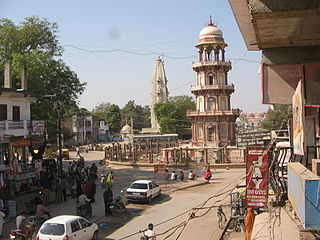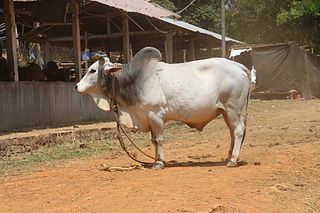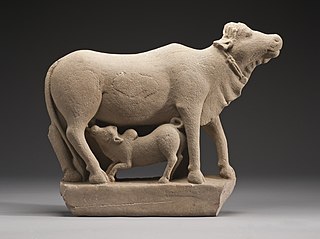Related Research Articles

The water buffalo, also called the domestic water buffalo or Asian water buffalo, is a large bovid originating in the Indian subcontinent and Southeast Asia. Today, it is also found in Italy, the Balkans, Australia, North America, South America and some African countries. Two extant types of water buffalo are recognized, based on morphological and behavioural criteria: the river buffalo of the Indian subcontinent and further west to the Balkans, Egypt and Italy and the swamp buffalo, found from Assam in the west through Southeast Asia to the Yangtze valley of China in the east.

Mehsana, also spelled Mahesana, is a city and municipality in Mehsana district, in the Indian state of Gujarat. Established in 14th century, the city was under Gaekwads of Baroda State from 18th century to the independence of India in 1947. The municipality was established in 1919–20. The town has population of about 185,000. Dairy, oil and natural gas are major industries while there are several small and medium enterprises in the city.

Banaskantha district is one of the thirty-three districts of the Gujarat state of India. The administrative headquarters of the district is at Palanpur which is also its largest city. The district is located in the Northeast of Gujarat and is presumably named after the West Banas River which runs through the valley between Mount Abu and Aravalli Range, flowing to the plains of Gujarat in this region and towards the Rann of Kutch. The district is famous for the Ambaji temple which draws many tourists. It covers an area of 12703 km2 and is the second largest district in the state.

Mehsana district is one of the 33 districts of Gujarat state in western India. Mehsana city is the administrative headquarters of this district. The district has a population of over 1.8 million and an area of over 4,500 km2. There are over 600 villages in this district with a population of 2,035,064 of which 22.40% were urban as of 2011.

The Gir or Gyr is an Indian breed of zebuine cattle originating in the state of Gujarat. Other names include Bhodah, Desan, Gujarati, Kathiawari, Sorthi and Surti.

The Murrah buffalo is a breed of water buffalo mainly kept for milk production. It originates in Haryana and Punjab of India, where it is kept in the districts of Bhiwani, Agra, Hisar, Rohtak, Jind, Jhajhar, Fatehabad, Gurgaon and the capital region of Delhi. It has been used to improve the milk production of dairy buffalo in other countries, such as Italy, Bulgaria and Egypt. A Murrah buffalo at the Lakshmi Dairy Farm in Punjab set a record of 26.335 kg (58.06 lb) of milk in the 2016 National Livestock Competition and Expo. In Brazil, this breed of buffalo is used for production of both meat and milk. Murrahs sell for a high price.

The Kankrej is an Indian breed of zebuine cattle. It originates from the arid region of the Rann of Kutch in the state of Gujarat, and in neighbouring Rajasthan. Under the name Kankaraj, it is also present in Tharparkar District, in Sindh, Pakistan. It is also known by the names Bannai, Nagar, Talabda, Vaghiyar, Wagad, Waged, Vadhiyar, Wadhiar, Wadhir and Wadial. It is a dual-purpose breed, used both for draught work and for milk production.

Many farmers in India depend on animal husbandry for their livelihood. In addition to supplying milk, meat, eggs, wool, their castings (dung) and hides, animals, mainly bullocks, are the major source of power for both farmers and dairies. Thus, animal husbandry plays an important role in the rural economy. The gross value of output from this sector was 8,123 billion Rupees in FY 2015–16.

The Philippine Carabao Center an attached agency of the Department of Agriculture, was established at Science City of Muñoz in Nueva Ecija province in 1992 to breed and cross carabao based on high-yield Murrah buffalo in the Philippines as a multi-purpose animal that can be raised for milk, meat, hide, and draft.

The Malvi or Malavi, also known as Manthani or Mahadeopuri, is breed of zebu cattle from the Malwa plateau in western Madhya Pradesh, in central India. It is a good draught breed; the milk yield of the cows is low.

Bhadwari is an improved water buffalo breed from Uttar Pradesh, India, that is kept for milk production mainly in the Agra and Etawah districts, and in the Bhind and Morena districts of Madhya Pradesh. Cows usually lactate during 272 days with an average milk yield of 752–810 kg (1,658–1,786 lb) in this period.

Nili-Ravi is a breed of domestic water buffalo of Punjab. It is distributed principally in Pakistan and India, concentrated in the Punjab region. It is similar to the Murrah breed of buffalo, and is reared mainly for dairy use. The average milk yield is approximately 2000 kg per year; the record yield is 6535 kg in a lactation of 378 days.

Saldi is a village in the Mehsana District, Gujarat, India, Pin Code 382730, situated on State Highway 217 between Gandhinagar and Mehsana. Saldi represents a typical countryside village of India. It borders the following villages: langhnaj, Veda, Parsa, Charadu, Vadasma, Shankarpura, Khata Amba, Khoraj and Himatpura. Saldi is famous for its temple of Pimpleshwar Mahadev, also known as Saldiya Mahadev.

The Mehsana District Cooperative Milk Producers' Union Limited, popularly known as Dudhsagar Dairy, is a division of Gujarat Cooperative Milk Marketing Federation which is under the ownership of Ministry of Cooperation of the Government of Gujarat.
Tundav is a village in the Mehsana district in the north of Gujarat, India. As of 2011, it had a population of 4,280. Tundav is in Unjha tehsil of the Mehsana district, situated between cities Unjha, Patan and Sidhpur. Tundav is a gram panchayat.
Central Institute for Research on Buffaloes, Hisar, a publicly funded, institute for water buffalo research. It is located 170 kilometres (110 mi) from Delhi, at Hisar in the north Indian state of Haryana. It has a sub-campus, Bir Dosanjh, at Nabha. CIRB operates a nationwide network of 10 research centres working on breed improvement of the 7 main native breeds. CIRB, with over 20 laboratories for buffalo research, is the world's largest buffalo research institute with the widest range of breeds under study. With the aim of improving breeds and dissemination of information, CIRB has sold over 1,000 bulls, conducted ~200,000 artificial insemination in the field for the farmers' buffaloes with a 41% conception rate, distributed ~520,000 progeny tested frozen semen kits to 45,000 farmers and over 250 institutes, imparted training to several thousand farmers on advanced buffalo husbandry, and created the world's first online Buffalopedia in several languages. It has a large research partner network across India and the globe. It is the second institute to successfully clone a buffalo in 2016, after the first successful cloning was achieved by the National Dairy Research Institute, Karnal in 2010. In July 2017, the Indian Council of Agricultural Research ranked CIRB Hisar as India's number one Buffalo research institute for the year 2016–17.
Of the more than 800 cattle breeds recognized worldwide, India had 27 acknowledged indigenous breeds of cattle and 7 breeds of buffaloes. As of 2018 the ICAR recognized 50 breeds that are indigenous in India, of which two cattle breeds and three buffalo breeds were added in 2018. Local conservation programs are endeavouring to maintain the purity of breeds such as Tharparkar, dwarf cattle such as Kasaragod, and Kankrej, Amrit Mahal and Kangayam. On the basis of main uses Indigenous cattle breeds are classified in to milch, draft, and dual purpose.
Aithor is a village in Unjha Taluka of Mehsana district, Gujarat, India.
Banni buffalo, which are also known as "Kutchi" or "Kundi", is a breed of buffalo found primarily in the Kutch district of Gujarat, India. The word 'Banni' is specific to not only the buffaloes but as well as the pasture grass species which are native to this region. This breed of buffaloes is usually bred and preserved by a local community found in Kutch, called the 'Maldharis'. An average Banni buffalo yields around 12 to 18 litres of milk each day.

Dairy plays a significant part in numerous aspects of Indian society, including cuisine, religion, culture, and the economy.
References
- 1 2 3 4 Moioli, Bianca; Borghese, Antonio (2004). Chapter III BUFFALO BREEDS AND MANAGEMENT SYSTEMS (PDF) (Report).
- 1 2 Pundir, R.K.; et al. (2000). "Characterization of Mehsana Buffaloes in India" (PDF). Animal Genetic Resources Information. 28: 53–62. doi:10.1017/S101423390000136X. Archived from the original (PDF) on 2019-02-14. Retrieved 2018-03-15.
- Dr. Vijaya Salunke (2007). "Animal Resources". India: Human Environment. Geography Standard (Grade) IX. Pune: Secretary Maharashtra State Board of Secondary and Higher Secondary Education. p. 31.